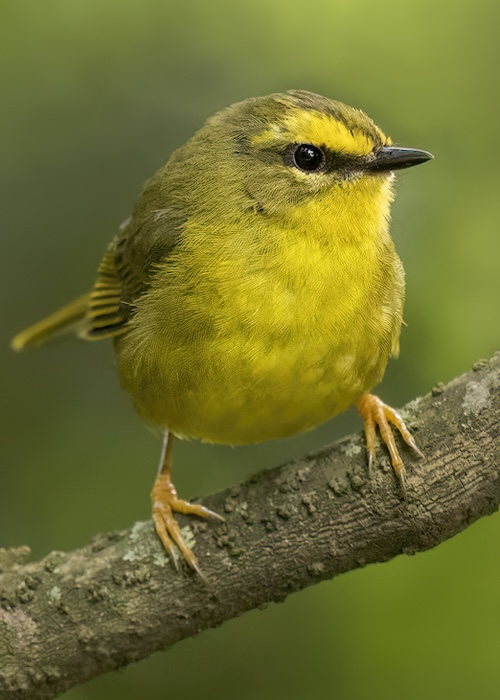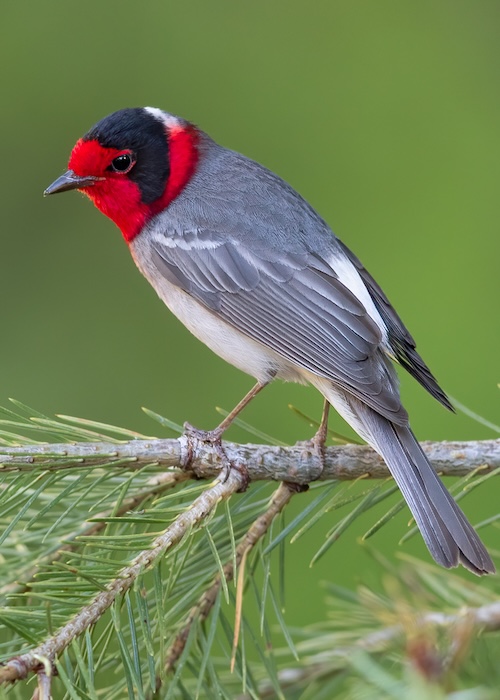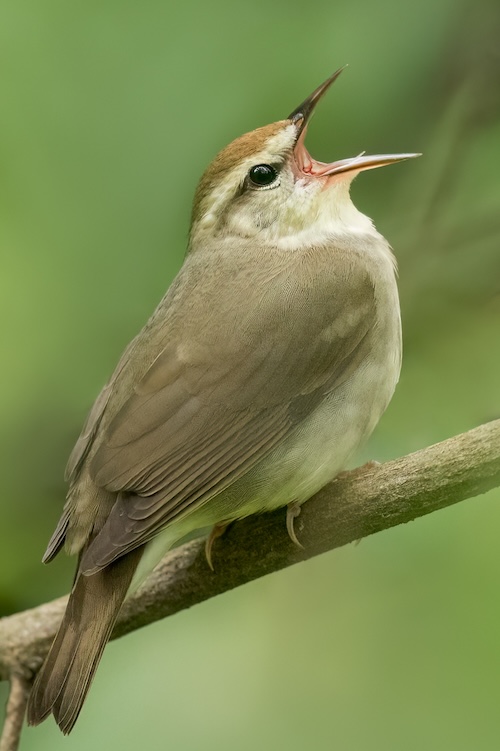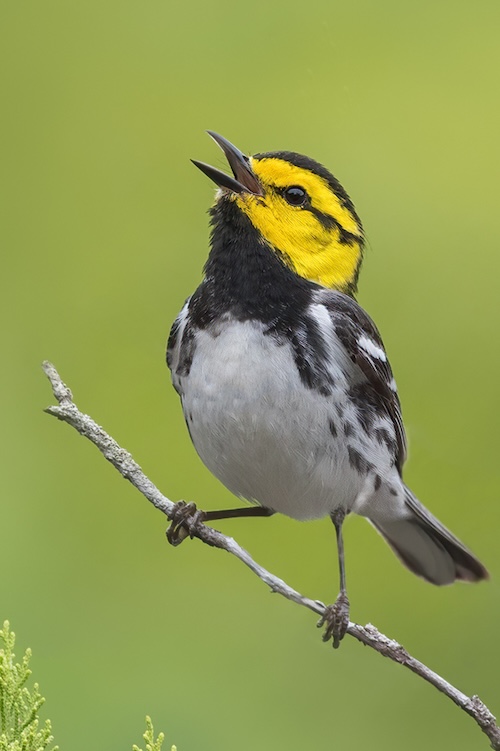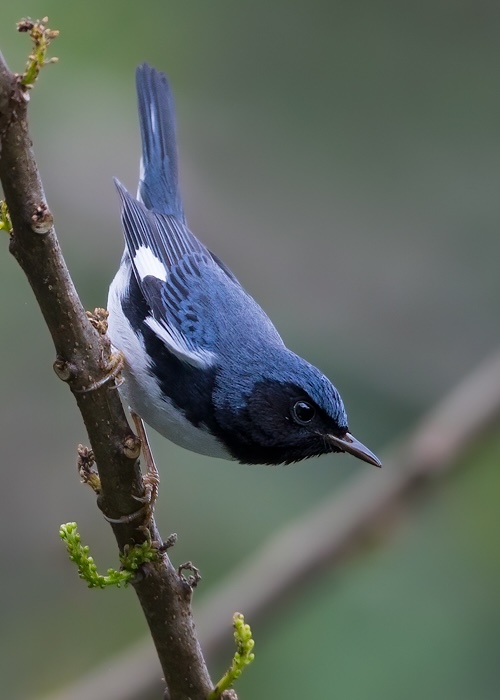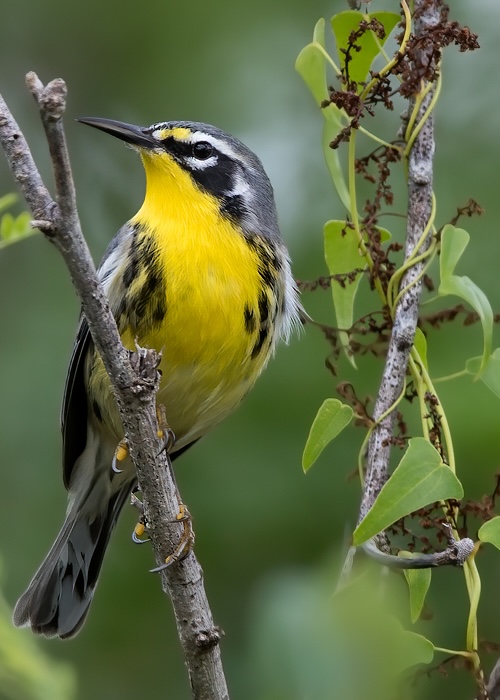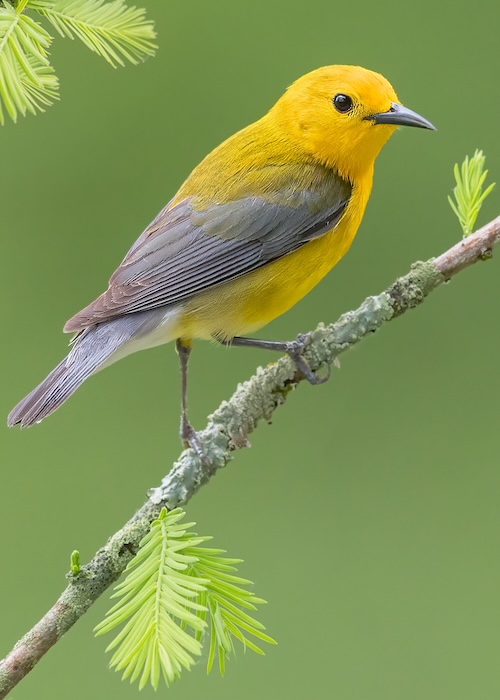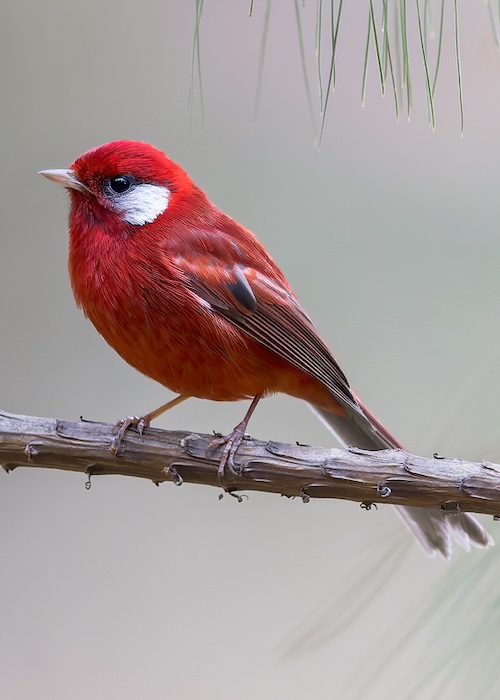Parulidae – New World Warblers
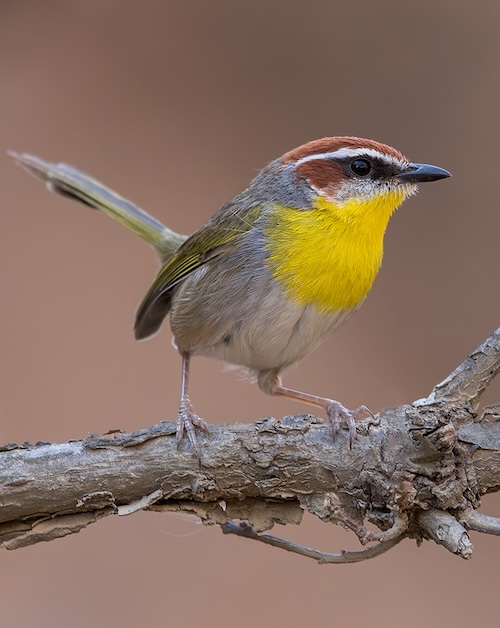
The Parulidae or New World warblers (sometimes wood-warblers) are a family of over one hundred small, often colourful, passerines, which are restricted to the New World. Nowhere else, however, do warblers sport the diversity and stunning beauty of the parulids.
The scientific name for the family, Parulidae, originates from the fact that Linnaeus (1758) named the Northern Parula as a tit, Parus americanus, and, as taxonomy developed, the genus name was modified first to Parulus and then to Parula. The family name derives from the name for the genus. They are not closely related to any of the other birds called warblers in the old-world and Australasia. They are more closely related to the Icterids. A recent (2010) molecular, phylogenetic study has greatly reordered the genera and many species.
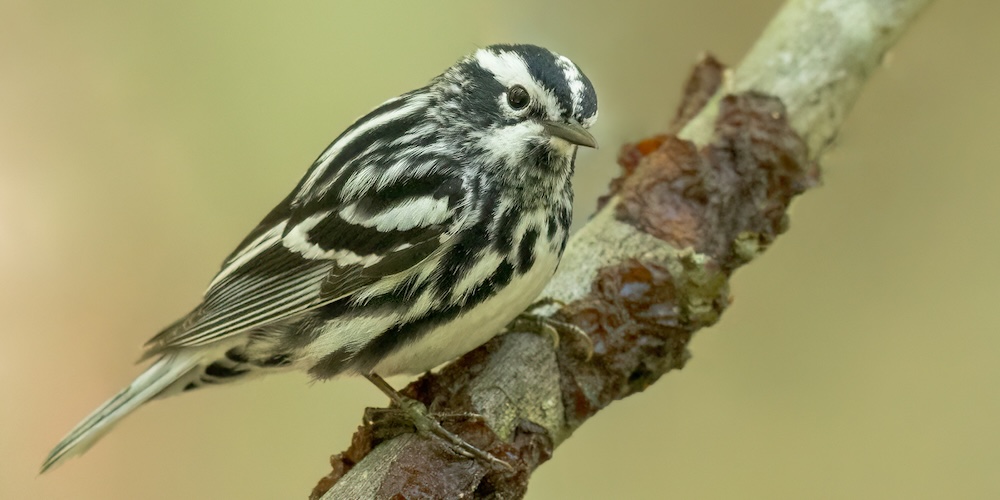
Black-and-white Warbler Mniotilta varia
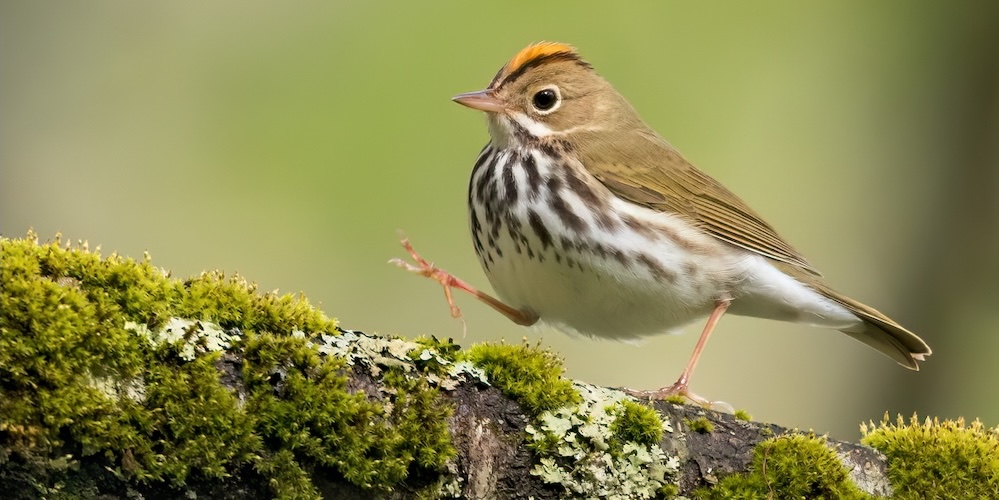
Ovenbird Seiurus aurocapilla
It is likely that this group originated in northern Central America, where the greatest number of species and diversity between them is found. From there they spread north during the interglacial periods, mainly as migrants, returning to the ancestral region in winter. Two genera, Myioborus and Basileuterus seem to have colonised South America early, perhaps before the two continents were linked, and together constitute most warbler species of that region.
|
|
|
|
Pale-legged Warbler Myiothlypis signata |
Red-faced Warbler Cardellina rubrifrons |
|
|
|
|
Swainson’s Warbler Limnothlypis swainsonii |
Golden-cheeked Warbler Setophaga chrysoparia |
|
All photographs on this page courtesy of ©Dubi Shapiro (unless otherwise attributed) |
|
Most are arboreal, but some, like the ovenbird and the two waterthrushes, are primarily terrestrial. Most members of this family are insectivores. All the warblers are fairly small. The smallest species is Lucy’s Warbler Oreothlypis luciae, at about 6.5g and 10.6cm. The Parkesia waterthrushes, the Ovenbird, the Russet-crowned Warbler and Semper’s Warbler, all of which can exceed 15cm and 21g, might be considered the largest.
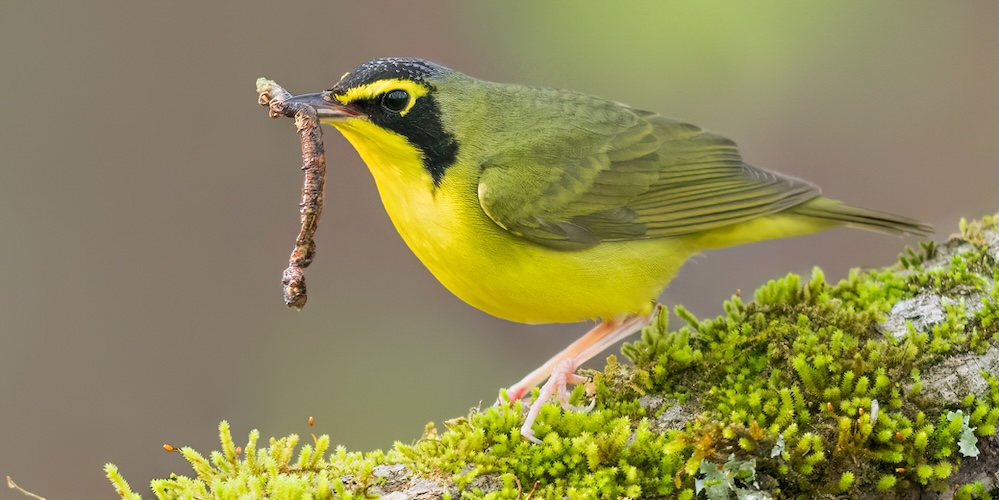
Kentucky Warbler Geothlypis formosa
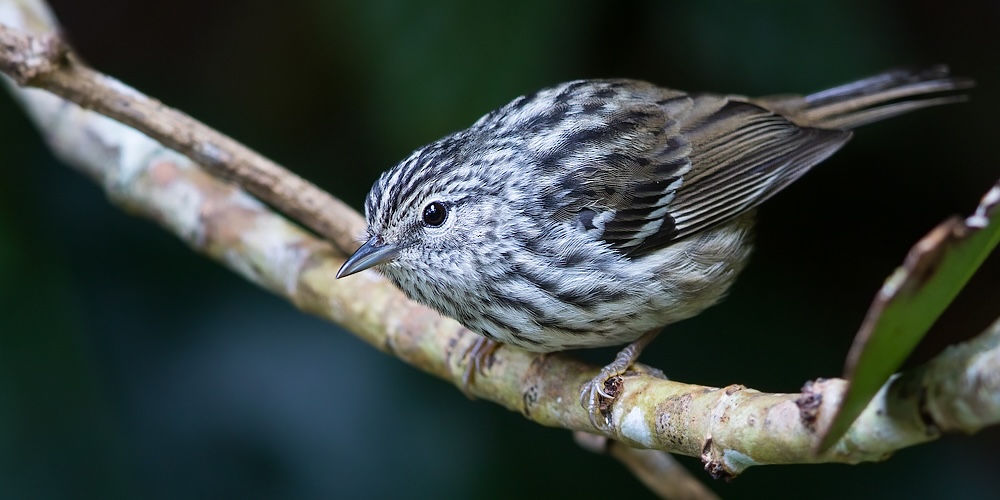
Arrowhead Warbler Setophaga pharetra
The migratory species tend to lay larger clutches of eggs, typically up to six, since the hazards of their journeys mean that many individuals will have only one chance to breed. In contrast, the laying of two eggs is typical for many tropical species, since the chicks can be provided with better care, and the adults are likely to have further opportunities for reproduction.
|
|
|
|
Black-throated Blue Warbler Setophaga caerulescens |
Bahama Warbler Setophaga flavescens |
|
|
|
|
Prothonotary Warbler Protonotaria citrea |
Red Warbler Cardellina rubra |
Many migratory species, particularly those which breed further north, have distinctive male plumage at least in the breeding season, since males need to reclaim territory and advertise for mates each year. This tendency is particularly marked in the large genus Setophaga. In contrast, resident tropical species, which pair for life, show little if any sexual dimorphism. There are exceptions. The Parkesia waterthrushes and Ovenbird are strongly migratory, but have identical male and female plumage, whereas the mainly tropical and sedentary yellowthroats are sexually dimorphic.
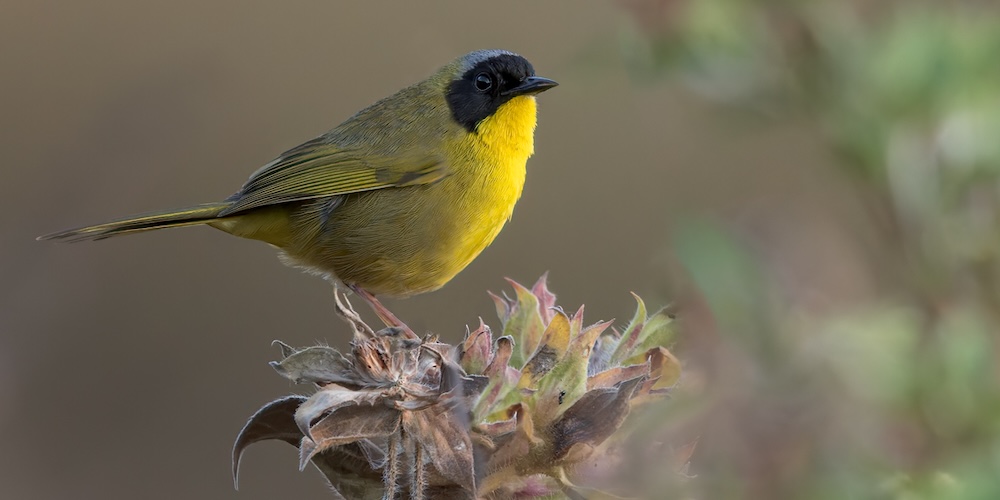
Hooded Yellowthroat Geothlypis nelsoni
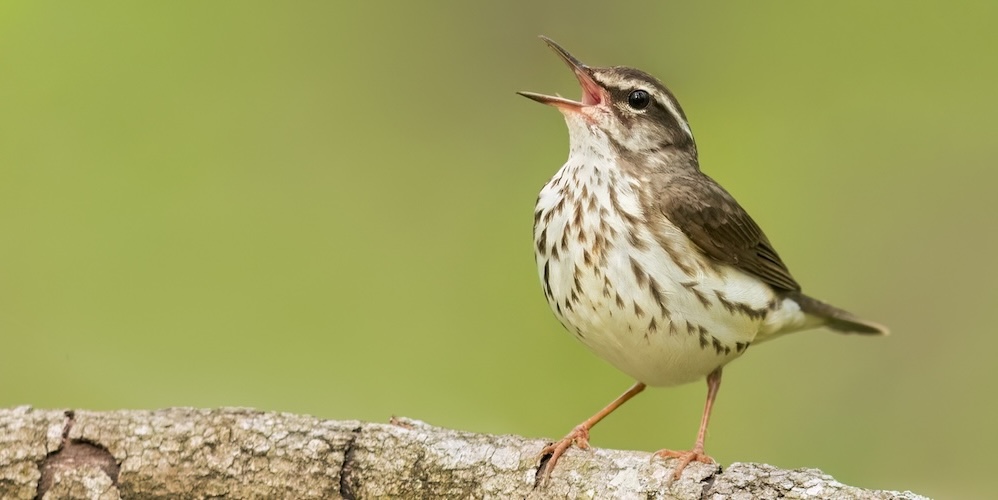
Louisiana Waterthrush Parkesia motacilla
Although a good many are tropical residents, almost half are long-distance migrants that breed in North America and spend the winter in the tropics. Recent phylogenetic analyses show that parulids originated from northern migrants rather than from the tropics. The northern migrants are more brightly coloured in summer than in the autumn, and birdwatchers can struggle to separate the many sombrely clad species during autumn migratory stopovers. Studies of warblers from the northeastern United States have taught us much about community ecology and about the physiological and ecological implications of small-landbird migration.
-
Number of bird species: 116
(As at December 2025)
According to the recently (2025) amalgamated AviList, there are one hundred and sixteen species, in eighteen genera in the Parulidae family. They are:
Ovenbird Seiurus aurocapilla
Northern Waterthrush Parkesia noveboracensis
Louisiana Waterthrush Parkesia motacilla
Worm-eating Warbler Helmitheros vermivorum
Black-and-white Warbler Mniotilta varia
Prothonotary Warbler Protonotaria citrea
Swainson’s Warbler Limnothlypis swainsonii
Bachman’s Warbler Vermivora bachmanii
Golden-winged Warbler Vermivora chrysoptera
Blue-winged Warbler Vermivora cyanoptera
Flame-throated Warbler Oreothlypis gutturalis
Crescent-chested Warbler Oreothlypis superciliosa
Tennessee Warbler Leiothlypis peregrina
Orange-crowned Warbler Leiothlypis celata
Colima Warbler Leiothlypis crissalis
Lucy’s Warbler Leiothlypis luciae
Nashville Warbler Leiothlypis ruficapilla
Virginia’s Warbler Leiothlypis virginiae
Connecticut Warbler Oporornis agilis
Semper’s Warbler Leucopeza semperi
Mourning Warbler Geothlypis philadelphia
MacGillivray’s Warbler Geothlypis tolmiei
Grey-crowned Yellowthroat Geothlypis poliocephala
Southern Yellowthroat Geothlypis velata
Masked Yellowthroat Geothlypis aequinoctialis
Black-lored Yellowthroat Geothlypis auricularis
Kentucky Warbler Geothlypis formosa
Black-polled Yellowthroat Geothlypis speciosa
Hooded Yellowthroat Geothlypis nelsoni
Olive-crowned Yellowthroat Geothlypis semiflava
Bahama Yellowthroat Geothlypis rostrata
Common Yellowthroat Geothlypis trichas
Altamira Yellowthroat Geothlypis flavovelata
Belding’s Yellowthroat Geothlypis beldingi
Whistling Warbler Catharopeza bishopi
Plumbeous Warbler Setophaga plumbea
Arrowhead Warbler Setophaga pharetra
Elfin Woods Warbler Setophaga angelae
Kirtland’s Warbler Setophaga kirtlandii
American Redstart Setophaga ruticilla
Hooded Warbler Setophaga citrina
Black-throated Blue Warbler Setophaga caerulescens
Cerulean Warbler Setophaga cerulea
Northern Parula Setophaga americana
Tropical Parula Setophaga pitiayumi
Magnolia Warbler Setophaga magnolia
Blackburnian Warbler Setophaga fusca
Blackpoll Warbler Setophaga striata
Bay-breasted Warbler Setophaga castanea
Chestnut-sided Warbler Setophaga pensylvanica
American Yellow Warbler Setophaga aestiva
Mangrove Warbler Setophaga petechia
Cape May Warbler Setophaga tigrina
Palm Warbler Setophaga palmarum
Myrtle Warbler Setophaga coronata
Bahama Warbler Setophaga flavescens
Yellow-throated Warbler Setophaga dominica
Olive-capped Warbler Setophaga pityophila
Pine Warbler Setophaga pinus
Prairie Warbler Setophaga discolor
Vitelline Warbler Setophaga vitellina
Adelaide’s Warbler Setophaga adelaidae
St. Lucia Warbler Setophaga delicata
Barbuda Warbler Setophaga subita
Black-throated Grey Warbler Setophaga nigrescens
Grace’s Warbler Setophaga graciae
Black-throated Green Warbler Setophaga virens
Golden-cheeked Warbler Setophaga chrysoparia
Hermit Warbler Setophaga occidentalis
Townsend’s Warbler Setophaga townsendi
Grey-headed Warbler Myiothlypis griseiceps
Santa Marta Warbler Myiothlypis basilica
Citrine Warbler Myiothlypis luteoviridis
White-striped Warbler Myiothlypis leucophrys
Flavescent Warbler Myiothlypis flaveola
White-rimmed Warbler Myiothlypis leucoblephara
Pale-legged Warbler Myiothlypis signata
Black-crested Warbler Myiothlypis nigrocristata
Buff-rumped Warbler Myiothlypis fulvicauda
Riverbank Warbler Myiothlypis rivularis
Two-banded Warbler Myiothlypis bivittata
Choco Warbler Myiothlypis chlorophrys
Cuzco Warbler Myiothlypis chrysogaster
Grey-throated Warbler Myiothlypis cinereicollis
White-lored Warbler Myiothlypis conspicillata
Grey-and-gold Warbler Myiothlypis fraseri
Russet-crowned Warbler Myiothlypis coronata
Fan-tailed Warbler Basileuterus lachrymosus
Rufous-capped Warbler Basileuterus rufifrons
Chestnut-capped Warbler Basileuterus delattrii
Black-cheeked Warbler Basileuterus melanogenys
Pirre Warbler Basileuterus ignotus
Golden-browed Warbler Basileuterus belli
Golden-crowned Warbler Basileuterus culicivorus
Black-eared Warbler Basileuterus melanotis
Tacarcuna Warbler Basileuterus tacarcunae
Three-striped Warbler Basileuterus tristriatus
Yungas Warbler Basileuterus punctipectus
Three-banded Warbler Basileuterus trifasciatus
Canada Warbler Cardellina canadensis
Wilson’s Warbler Cardellina pusilla
Red-faced Warbler Cardellina rubrifrons
Pink-headed Warbler Cardellina versicolor
Red Warbler Cardellina rubra
Painted Whitestart Myioborus pictus
Slate-throated Whitestart Myioborus miniatus
Brown-capped Whitestart Myioborus brunniceps
Tepui Whitestart Myioborus castaneocapilla
Paria Whitestart Myioborus pariae
Guaiquinima Whitestart Myioborus cardonai
White-faced Whitestart Myioborus albifacies
Collared Whitestart Myioborus torquatus
Yellow-crowned Whitestart Myioborus flavivertex
Golden-fronted Whitestart Myioborus ornatus
Spectacled Whitestart Myioborus melanocephalus
White-fronted Whitestart Myioborus albifrons
-
Peterson Field Guide to the Warblers of North America
| By Jon L Dunn & Kimball L Garrett | Houghton Mifflin | 1997 | Paperback | 656 pages, Colour photos & illustrations, maps | ISBN: 9780395783214 Buy this book from NHBS.com -
The Warbler Guide
| By Tom Stephenson & Scott Whittle | Princeton University Press | 2013 | Paperback | 560 pages | 1000+ colour photos | 50 maps | ISBN: 9780691154824 Buy this book from NHBS.com -
Warblers in Your Pocket - A Guide to the Wood-Warblers of the Upper Midwest
| By Dana Gardner | University of Iowa Press | 2016 | Unbound | 1 pages, 14 colour illustrations | ISBN: 9781609384296 Buy this book from NHBS.com
-
Parulidae
Family AccountParulidae is part of the New World nine-primaried oscine radiation of the superfamily Passeroidea. -
Parulidae
Family AccountThe New World warblers or wood-warblers are a group of small, often colorful, passerine birds that make up the family Parulidae and are restricted to the New...
Given the number of species in this family, Fatbirder does not provide quick links to all of them. However, the entries below do include links to representatives of every genera, all those illustrated and some of the most often encountered, iconic or sought-after species.
-
Arrowhead Warbler Setophaga pharetra
Species AccountThe arrowhead warbler (Setophaga pharetra) is a species of passerine in the family Parulidae, endemic to Jamaica. -
Arrowhead Warbler Setophaga pharetra
Species AccountSound archive and distribution map. -
Bachman's Warbler Vermivora bachmanii
Species AccountBachman's warbler (Vermivora bachmanii) is a possibly extinct passerine migratory bird. This warbler was a migrant, breeding in swampy blackberry and cane -
Bachman's Warbler Vermivora bachmanii
Species AccountSound archive and distribution map. -
Bahama Warbler Setophaga flavescens
Species AccountThe Bahama warbler (Setophaga flavescens) is an endangered species of bird in the family Parulidae that is endemic to The Bahamas. -
Bahama Warbler Setophaga flavescens
Species AccountSound archive and distribution map. -
Black-and-White Warbler Mniotilta varia
Species AccountThe black-and-white warbler (Mniotilta varia) is a species of New World warbler, the only member of its genus, Mniotilta. -
Black-and-White Warbler Mniotilta varia
Species AccountSound archive and distribution map. -
Black-throated Blue Warbler Setophaga caerulescens
Species AccountThe black-throated blue warbler (Setophaga caerulescens) is a small passerine bird of the New World warbler family. -
Black-throated Blue Warbler Setophaga caerulescens
Species AccountSound archive and distribution map. -
Blackpoll Warbler Dendroica striata
Species AccountThe blackpoll warbler (Setophaga striata) is a New World warbler. Breeding males are mostly black and white. -
Blackpoll Warbler Dendroica striata
Species AccountSound archive and distribution map. -
Brown-capped Whitestart Myioborus brunniceps
Species AccountThe brown-capped whitestart (Myioborus brunniceps), or, less accurately, the brown-capped redstart, is a species of bird in the Parulidae family. It is found in humid Andean forests and woodlands in Bolivia and north-western Argentina. It sometimes includes the tepui whitestart as a subspecies. -
Brown-capped Whitestart Myioborus brunniceps
Species AccountSound archive and distribution map. -
Cape May Warbler Setop[haga tigrina
Species AccountSound archive and distribution map. -
Cape May Warbler Setop[haga tigrina
Species AccountThe Cape May warbler (Setophaga tigrina) is a species of New World warbler. It breeds in northern North America. -
Connecticut Warbler Oporornis agilis
Species AccountThe Connecticut warbler (Oporornis agilis) is a small songbird of the New World warbler family. -
Connecticut Warbler Oporornis agilis
Species AccountSound archive and distribution map. -
Flame-throated Warbler Oreothlypis gutturalis
Species AccountThe flame-throated warbler (Oreothlypis gutturalis) is a small New World warbler. It is sometimes placed in the genera Vermivora and Parula. -
Flame-throated Warbler Oreothlypis gutturalis
Species AccountSound archive and distribution map. -
Golden-cheeked Warbler Setophaga chrysoparia
Species AccountThe golden-cheeked warbler (Setophaga chrysoparia) is an endangered species of bird that breeds in Central Texas, from Palo Pinto County southwestward... -
Golden-cheeked Warbler Setophaga chrysoparia
Species AccountSound archive and distribution map. -
Hooded Yellowthroat Geothlypis nelsoni
Species AccountThe hooded yellowthroat (Geothlypis nelsoni) is a species of bird in the family Parulidae. It is endemic to the highlands of Mexico... -
Hooded Yellowthroat Geothlypis nelsoni
Species AccountSound archive and distribution map. -
Kentucky Warbler Geothlypis formosa
Species AccountThe Kentucky warbler (Geothlypis formosa) is a small species of New World warbler. -
Kentucky Warbler Geothlypis formosa
Species AccountSound archive and distribution map. -
Louisiana Waterthrush Parkesia motacilla
Species AccountThe Louisiana waterthrush (Parkesia motacilla) is a New World warbler, that breeds in eastern North America and winters in the West Indies and Central America. -
Louisiana Waterthrush Parkesia motacilla
Species AccountSound archive and distribution map. -
Myrtle Warbler Setophaga coronata
Species AccountFour closely related North American bird forms—the eastern Myrtle Warbler (ssp coronata), its western counterpart, Audubon's Warbler (ssp group auduboni), the Northwest Mexican Black-fronted Warbler (ssp nigrifrons), and the Guatemalan Goldman's Warbler (ssp goldmani)—are periodically lumped as the Yellow-rumped Warbler (Dendroica coronata)… -
Myrtle Warbler Setophaga coronata
Species AccountSound archive and distribution map. -
Northern Waterthrush Parkesia noveboracensis
Species AccountThe northern waterthrush (Parkesia noveboracensis) is a species of ground-feeding migratory New World warbler of the genus Parkesia. -
Northern Waterthrush Parkesia noveboracensis
Species AccountSound archive and distribution map. -
Ovenbird Seiurus aurocapilla
Species AccountThe ovenbird (Seiurus aurocapilla) is a small songbird of the New World warbler family Parulidae. It is the only species placed in the genus Seiurus. -
Ovenbird Seiurus aurocapilla
Species AccountSound archive and distribution map. -
Pale-legged Warbler Myiothlypis signata
Species AccountSmall yellowish warbler of montane forest. Has light pink legs and a pale eyebrow. Compared to the similar Citrine Warbler, has a fainter facial pattern. -
Pale-legged Warbler Myiothlypis signata
Species AccountSound archive and distribution map. -
Palm Warbler Setophaga palmarum
Species AccountThe palm warbler (Setophaga palmarum) is a small songbird in the New World warbler family. Palm warbler. "Yellow" palm warbler in breeding plumage. -
Palm Warbler Setophaga palmarum
Species AccountSound archive and distribution map. -
Prothonotary Warbler Protonotaria citrea
Species AccountThe prothonotary warbler (Protonotaria citrea) is a small songbird of the New World warbler family. It is named for its plumage which resembles the yellow robes... -
Prothonotary Warbler Protonotaria citrea
Species AccountSound archive and distribution map. -
Red Warbler Cardellina rubra
Species AccountThe red warbler (Cardellina rubra) is a small passerine bird of the New World warbler family Parulidae endemic to the highlands of Mexico... -
Red Warbler Cardellina rubra
Species AccountSound archive and distribution map. -
Red-faced Warbler Cardellina rubrifrons
Species AccountThe red-faced warbler (Cardellina rubrifrons) is a species of New World warbler. Mature red-faced warblers are small birds, 14 cm (51⁄2 in) long. -
Red-faced Warbler Cardellina rubrifrons
Species AccountSound archive and distribution map. -
Rufous-capped Warbler Basileuterus rufifrons
Species AccountSound archive and distribution map. -
Rufous-capped Warbler Basileuterus rufifrons
Species AccountThe rufous-capped warbler (Basileuterus rufifrons) is a New World warbler native from Mexico south to Guatemala, rarely occurring as far north as southeastern Arizona and south Texas. -
Semper's Warbler Leucopeza semperi
Species AccountSemper's warbler (Leucopeza semperi), local name pied-blanc, is a possibly extinct passerine bird of the New World warbler family, Parulidae. -
Semper's Warbler Leucopeza semperi
Species AccountSound archive and distribution map. -
Swainson's Warbler Limnothlypis swainsonii
Species AccountSwainson's warbler (Limnothlypis swainsonii) is a small species of New World warbler. -
Swainson's Warbler Limnothlypis swainsonii
Species AccountSound archive and distribution map. -
Tennessee Warbler Leiothlypis peregrina
Species AccountThe Tennessee warbler (Leiothlypis peregrina) is a New World warbler that breeds in eastern North America and winters in southern Central America. -
Tennessee Warbler Leiothlypis peregrina
Species AccountSound archive and distribution map. -
Whistling Warbler Catharopeza bishopi
Species AccountThe whistling warbler (Catharopeza bishopi) is a species of bird in the New World warbler family. It is monotypic within the genus Catharopeza. -
Whistling Warbler Catharopeza bishopi
Species AccountSound archive and distribution map. -
Wilson's Warbler Cardellina pusilla
Species AccountThe Wilson's warbler (Cardellina pusilla) is a small New World warbler. It is greenish above and yellow below, with rounded wings and a long, slim tail. -
Wilson's Warbler Cardellina pusilla
Species AccountSound archive and distribution map. -
Worm-eating Warbler Helmitheros vermivorum
Species AccountThe worm-eating warbler (Helmitheros vermivorum) is a small New World warbler that breeds in the Eastern United States and migrates to southern Mexico... -
Worm-eating Warbler Helmitheros vermivorum
Species AccountSound archive and distribution map. -
Yellow Warbler Setophaga petechia
Species AccountSpecies account -
Yellow Warbler Setophaga petechia
Species AccountSound archive and distribution map.
-
Daniel Edelstein - Warblerwatch
WebsiteAs a Consulting Biologist (and as a birding guide since 1981), Daniel Edelstein works full-time in the environmental consulting field. Concurrently, he often leads San Francisco Bay Area birding tours and California bird watching trips. Daniel teaches diverse college-level bird classes — “Fundamentals of Ornithology,” “Bird Song Ecology/Birding By Ear, (see his “Top Ten Tips For Improving Your Birding By Ear,”) “Waterbirds,” “Raptors,” “Wood-Warblers on the West Coast (& Midwest/East Coast),” and “The Miracle of Migration: The Amazing Nomadic Lives of Birds & Other Animals” at Merritt College (where he is an Adjunct Faculty member in its Biology Dept.) and at other adult education settings… -
Visualizing Western Warbler Songs
WebsiteThose of you who began birding before 1980 will probably remember that the field guide of choice was A Guide to the Field Identification of Birds of North America now usually referred to as the Golden Guide. Produced by Golden Press, it was the best comprehensive guide to North American Birds at the time. It was among the first field guides to place illustrations next to text and include range maps in the margins. It was one of the first pocket sized field guides to illustrate birds in natural and varied settings. And then there were those wonderful sonograms…

